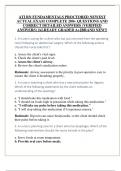Exam (elaborations)
ATI RN FUNDAMENTALS PROCTORED NEWEST ACTUAL EXAM COMPLETE 200+ QUESTIONS AND CORRECT DETAILED ANSWERS (VERIFIED ANSWERS) |ALREADY GRADED A+||BRAND NEW!!
- Course
- Institution
ATI RN FUNDAMENTALS PROCTORED NEWEST ACTUAL EXAM COMPLETE 200+ QUESTIONS AND CORRECT DETAILED ANSWERS (VERIFIED ANSWERS) |ALREADY GRADED A+||BRAND NEW!!
[Show more]



